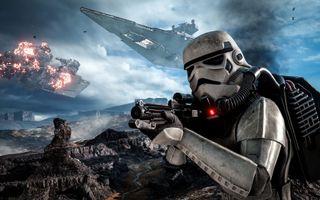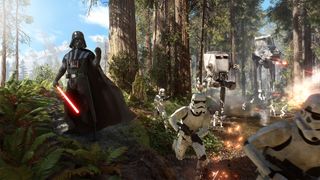What we want from Star Wars Battlefront 2
Some small and big changes we'd like to see in DICE's shooter sequel.

Star Wars Battlefront, for all the weight behind its titanic namesake, has largely floundered against the competition. It sold well, but over a year later, Andy Kelly’s branding of Battlefront as a “rote, by-the-numbers FPS” with a Star Wars skin stretched over it has stuck true, especially with it now in the shadow of Battlefield 1.
Gorgeous visuals of tree-splintering laser-fights on Endor or a John Williams victory fanfare can’t seem to cut against its dwindling community’s deep-seated laments of simplistic gunplay and initially sparse content. It trades nuance for reference; it feels like a friend articulating a hypothetical Star Wars matchup (“What if Han Solo and Darth Vader dueled on top of the Millennium Falcon?”) while glossing over the finer details.
With a new Battlefront arriving sometime this year, DICE holds the potential to deliver a sequel with the same brimming Star Wars excitement but of more ambitious design over conservative limitations. Here’s a few thoughts on which improvements will best help Battlefront 2.
Embrace the eras
Battlefront kept to the original trilogy as a timing move to release near to the Force Awakens film. Out of the five subsequent expansion packs, only two provided planets outside the trilogy: the single-map Jakku and the capstone Scarif DLC (unsolicited trivia: Scarif was named after a mislabeled Starbucks order) from the later Rogue One film. With sequel trilogy content already confirmed for Battlefront 2, the opportunity is ripe for delving further into the Star Wars canon.
There’s plenty to choose from: the prequel films, the popular Clone Wars period, the bountiful heroes and villains from the Rebels TV spin-off, scores of literature and comics. The locations we’ll visit shouldn’t be forced in lockstep to a tie-in window with a film premiere. A wider diversity of eras and planets can only strengthen Battlefront’s appeal.

Let the story flow
We’re due for a fresh wave of fine Star Wars storytelling—in fact, both Dead Space’s Visceral and Titanfall’s Respawn are committed to upcoming single-player Star Wars projects. DICE is following suit by promising a full campaign for Battlefront 2, a sore absence from the first game considering how its exquisite map detail could’ve easily translated into an exciting campaign. Unlike its fellow studios, DICE isn’t well-known for single-player prowess; the press-F style of its flagship Battlefield series isn’t exactly a bastion of narrative creativity.
Battlefront 2 critically needs a stellar campaign. The offline options of its older brother were fair diversions from the multiplayer main course, but even the bot-filled Skirmish and challenging Survival modes were largely ornamental testing grounds for a new weapon or Star Card unlock. That doesn’t leave much room for a lackluster campaign.
The biggest gaming news, reviews and hardware deals
Keep up to date with the most important stories and the best deals, as picked by the PC Gamer team.
Missions need substance beyond a gilded conveyor belt, and they need flexibility for different tactics and playstyles. The constant strife between Jedi, Sith, Empire, and Republic is a sturdy enough stage to eschew an overarching plot if necessary; a mix of Battlefield 1’s episodic style and Battlefield Hardline’s talented voice acting would be grand. The lauded Galactic Conquest mode from Pandemic’s original Battlefront is a prime example of impact, where entire planets could be captured and an army’s power and supplies hinged on victories or losses. Whatever DICE decides upon doesn’t have to be a cookie-cut copy of what worked before, but it has to be long, fun, and engaging to stick. No pressure.

A great war in Star Wars
It doesn’t take much to pick up any of Battlefront’s assorted carbines, pistols, or rifles and swing into a slaying spree. Intimate weapon familiarity wavers beside forgivably slim recoil patterns and soft health bars. Acing squads or gunning down the Emperor and his stupid lightning jazz-hands feels simple. Surprise! It’s meant to be.
Dispensing complexity for the sake of accessibility ultimately hampered Battlefront’s appeal to a larger shooter crowd. Battlefront 2 doesn’t need to blindly oblige hardcore enthusiasts in turn, but it does stand to benefit from a blend of approachability and depth. Something as singular as a variation of Battlefield’s attachment system would provide players the added flexibility of customizing their weapons. Expanding the Star Card system with side grade assortments (perhaps a short-range hover version of the Jump Pack or cookable, low-yield grenades) would help shape spontaneous role-shaping a la Team Fortress 2.
It’s fine if the actual feel of shooting Battlefront 2’s guns stays the same—lasers are literally straightforward compared to bullets, after all. The low-entry, high-skill formula proven in successful shooters such as Overwatch and Rainbow Six Siege could be comfortably accommodated with Battlefront 2’s scale. Its players should be encouraged with a sense of self-improvement and a drive to return and hone their talents.
Modular maps
In designing Battlefront’s maps, DICE tailored specific maps for specific modes: Hoth’s sprawling Outpost Beta for the 40-man Supremacy or Walker Assault, Tatooine’s circular Rebel Depot for the smaller Blast or Cargo Run, and so on. This whittled down the selection of maps for a chosen mode to a scant few. Out of the 13 maps included at launch, only four supported Supremacy and Walker Assault. Such a meager rotation grew stale fast and stifled players who preferred only a few match types.
Battlefront 2 should instead adopt the interchangeable design seen in DLC maps such as Twilight on Hoth or Scarif’s beach base. Slicing large maps into smaller sections to appropriately fit each mode should greatly bolster map variety and avoid sending players to the shallow end of the pool if they only want to play one or two modes. A DLC plan embracing free map updates to keep the community together wouldn’t hurt. It’s the popular thing to do.
Omri Petitte is a former PC Gamer associate editor and long-time freelance writer covering news and reviews. If you spot his name, it probably means you're reading about some kind of first-person shooter. Why yes, he would like to talk to you about Battlefield. Do you have a few days?
Most Popular

